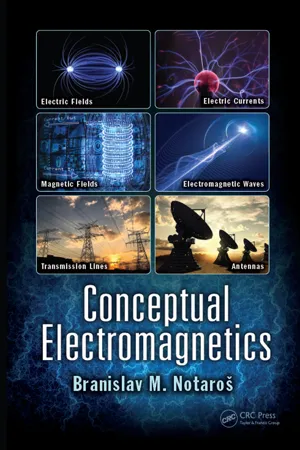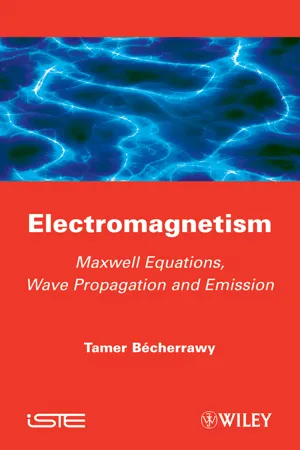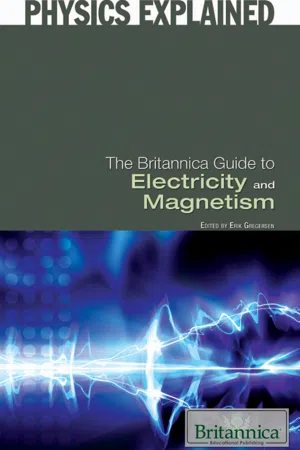Physics
Magnetostatic in Matter
Magnetostatics in matter refers to the study of magnetic fields in materials that are not in motion. It involves the analysis of the behavior of magnetic fields in different types of matter, including ferromagnetic, paramagnetic, and diamagnetic materials. The study of magnetostatics in matter is important in understanding the behavior of magnetic materials and their applications in various fields.
Written by Perlego with AI-assistance
Related key terms
Related key terms
1 of 4
Related key terms
1 of 3
4 Key excerpts on "Magnetostatic in Matter"
- eBook - ePub
- Branislav M. Notaroš(Author)
- 2017(Publication Date)
- CRC Press(Publisher)
MAGNETOSTATIC FIELD IN MATERIAL MEDIA IntroductionIn analysis of the magnetostatic field in the presence of magnetic materials, many basic concepts, physical laws, and mathematical techniques are entirely analogous to the corresponding concepts, laws, and techniques in electrostatics (Chapter 2 ). Magnetized materials can be represented by vast collections of tiny atomic current loops, i.e., magnetic dipoles, while the concept of permeability of a medium allows for macroscopic characterization of materials and their fields. The most important difference, however, with respect to the analysis of dielectric materials is the inherent nonlinear behavior of the most important class of magnetic materials, called ferromagnetics. This is a class of materials with striking magnetic properties (many orders of magnitude stronger than in other materials), with iron as a typical example. Analysis of magnetic circuits (consisting of ferromagnetic cores of different shapes with current-carrying windings), which is a culmination of our study of the magnetostatic field in material media, thus essentially resembles the dc analysis of nonlinear electric circuits. In addition, configurations of current-carrying conductors store magnetic energy. For systems that contain ferromagnetic materials with pronounced nonlinearity, the energy balance in the system includes so-called hysteresis losses in the material.5.1 Magnetization CurrentAccording to the elementary atomic model of matter, all materials are composed of atoms, each with a central fixed positively charged nucleus and a number of negatively charged electrons circulating around the nucleus in various orbits. Both these orbital motions and the inherent spins of the electrons about their own axes can be represented by small current loops, also referred to as magnetic dipoles. The magnetic moment of each loop is given by m = IS, where I is the current intensity of the loop and S is the loop surface area vector, oriented in accordance to the right-hand rule with respect to the reference direction of the current. With an applied magnetic field, these current loops experience torques, which lead to a net alignment of microscopic magnetic dipole moments with the external field and a net magnetic moment in the material, and this process is known as the magnetization of the material. However, instead of analyzing every single atom and all microscopic magnetic dipole moments, we introduce a macroscopic quantity termed the magnetization vector and defined as [note the analogy with Eq. (2.2) - eBook - ePub
- Anupam Garg(Author)
- 2012(Publication Date)
- Princeton University Press(Publisher)
16 Magnetostatics in matterOur purpose in this chapter is to obtain a theory for the spatially averaged or macroscopic magnetic field in matter and to develop models for the response of certain types of materials to applied magnetic fields. While the mathematical development parallels that of electrostatics in dielectrics, the physics is quite different. The biggest difference is that, unlike the electric case, the magnetic susceptibility may be either positive or negative, i.e., the magnetic response can either oppose or reinforce the applied field. The two cases are known as diamagnetic and paramagnetic , respectively. This difference can be traced to the lack of any work done by the magnetic field on a moving charge. Second, except for ferromagnets and superconductors, the response is much weaker than in the electric case. Thus, there is often little penalty for confusing the magnetic field B with the magnetizing field H , and many authors even use the symbols interchangeably. This leads to much confusion, which we shall avoid with only partial success.100 Magnetic permeability and susceptibility
In magnetostatics, where we study only steady-state situations, the macroscopic equations to be solved are Ampere’s law,and the law that B is solenoidal,As in the electrostatic case, one needs a constitutive relation between B and H to solve eqs. (100.1) and (100.2). For many materials a linear relationship holds to very good approximation over a large range. If the material is isotropic, we write1The dimensionless number μ (in the Gaussian system), or μ/μ 0 (in SI), is known as the permeability of the medium. It has the same value in the two systems. In solid or liquid crystals, it must be replaced by a tensor.We also define the magnetic susceptibility in parallel with the electric susceptibility:This is related to the permeability via It is also a dimensionless number, butFor the majority of materials for which eq. (100.3) is a good approximation,χmis very small, of order 10−5 . As mentioned above, unlikeχe,χmcan be either positive (paramagnets ) or negative (diamagnets ). Because of the smallness ofχm, if either a para- or diamagnetic body is placed in an external B - eBook - ePub
Electromagnetism
Maxwell Equations, Wave Propagation and Emission
- Tamer Becherrawy(Author)
- 2013(Publication Date)
- Wiley-ISTE(Publisher)
Chapter 7Magnetism in Matter
Before the discovery of the magnetic effects of electric current and charges, the understanding of magnetism pertained to permanent magnets. Even today, some of the magnetic properties of matter remain little understood and other properties remain to be explored. This does not prevent magnetism from underlying many applications, ranging from the magnetic compass to measurement instruments, electric generators and motors, magnetic tapes for sound and video recording and for computer data storage, magnetic levitation, etc. The purpose of this chapter is to introduce some basic elements of magnetism in matter.7.1. Types of magnetism
Some materials, said to be ferromagnetic , become magnetized if they are exposed to a magnetic field and they remain permanently magnetized if the magnetic field is removed. A magnetized body is equivalent to a magnetic moment M in a characteristic direction SN . An external magnetic field acts on this body and orients it in such a way that the field B enters the body at S and leaves it at N (Figure 7.1a ). Particularly, in the Earth's magnetic field, N points approximately toward the geographic North and S toward the South (Figure 7.1b ). However, contrary to the electric charges, which constitute an electric dipole, the “magnetic poles” cannot be separated and the concept of magnetic pole is simply an analogy with electric charges. Similar to dielectrics, which polarize if they are placed in an electric field, all materials become magnetized to some extent if they are submitted to the magnetic field B of an electric current or another magnetized body. Some materials (such as aluminum, chrome, platinum, etc.) acquire a magnetic moment in the direction of B , they are said to be paramagnetic . Other materials (such as silver, gold, copper, mercury, lead, etc.) acquire a magnetic moment in the opposite direction to B , they are said to be diamagnetic . A magnetized body produces its own magnetic field, which leaves the body near N and enters the body near S (Figure 7.1c ). - Britannica Educational Publishing, Erik Gregersen(Authors)
- 2010(Publication Date)
- Britannica Educational Publishing(Publisher)
CHAPTER 4 MAGNETISMM agnetism is a phenomenon associated with the motion of electric charges. This motion can take many forms. It can be an electric current in a conductor or charged particles moving through space, or it can be the motion of an electron in atomic orbit. Magnetism is also associated with elementary particles, such as the electron, that have a property called spin.FUNDAMENTALS
Basic to magnetism are magnetic fields and their effects on matter, as, for instance, the deflection of moving charges and torques on other magnetic objects. Evidence for the presence of a magnetic field is the magnetic force on charges moving in that field; the force is at right angles to both the field and the velocity of the charge. This force deflects the particles without changing their speed. The deflection can be observed in the electron beam of a television tube when a permanent magnet is brought near the tube. A more familiar example is the torque on a compass needle that acts to align the needle with the magnetic field of Earth. The needle is a thin piece of iron that has been magnetized—i.e., a small bar magnet. One end of the magnet is called a north pole and the other end a south pole. The force between a north and a south pole is attractive, whereas the force between like poles is repulsive. The magnetic field is sometimes referred to as magnetic induction or magnetic flux density; it is always symbolized by B . Magnetic fields are measured in units of tesla (T). (Another unit of measure commonly used for B is the gauss, though it is no longer considered a standard unit. One gauss equals 10−4 tesla.)A fundamental property of a magnetic field is that its flux through any closed surface vanishes. (A closed surface is one that completely surrounds a volume.) This is expressed mathematically by div B = 0 and can be understood physically in terms of the field lines representing B
Index pages curate the most relevant extracts from our library of academic textbooks. They’ve been created using an in-house natural language model (NLM), each adding context and meaning to key research topics.
Explore more topic indexes
Explore more topic indexes
1 of 6
Explore more topic indexes
1 of 4



